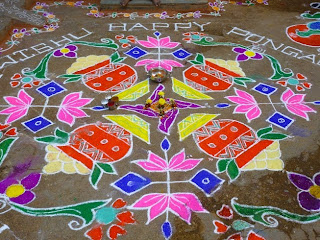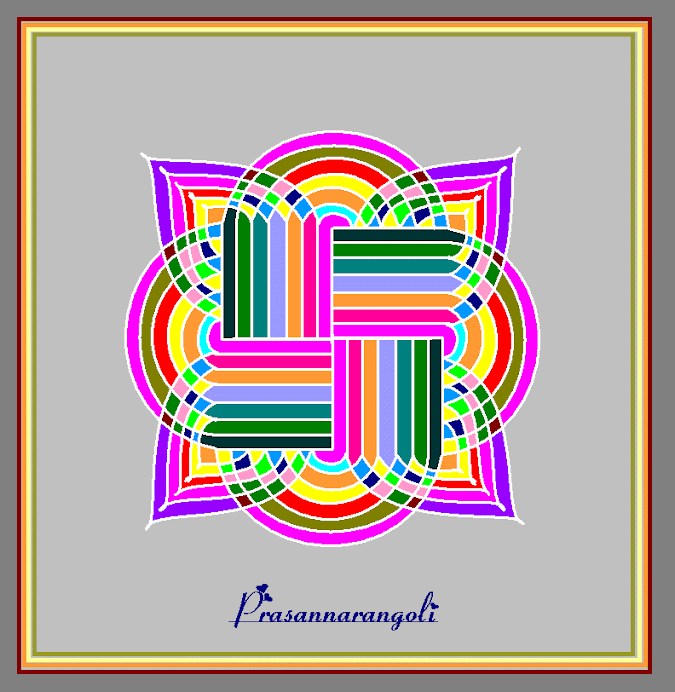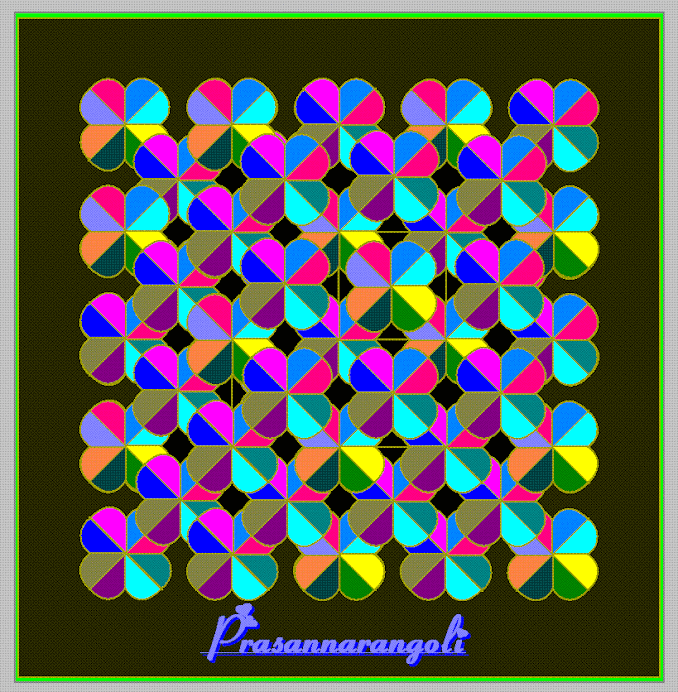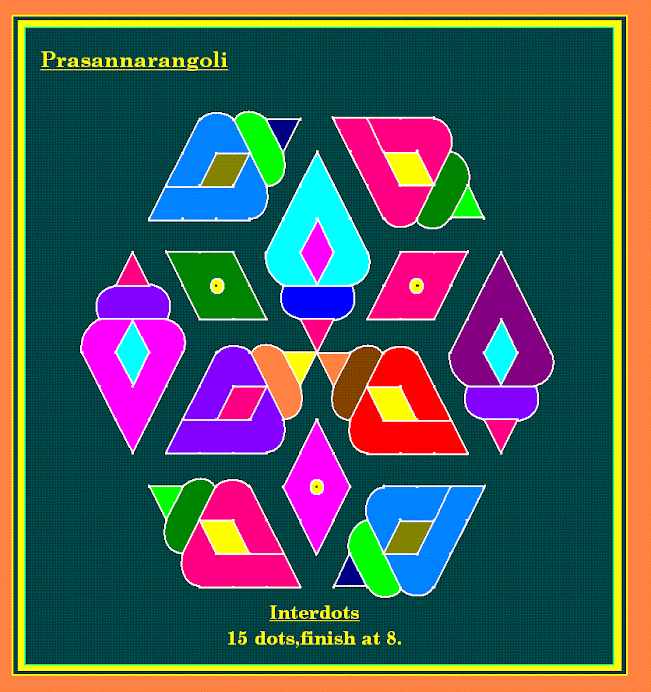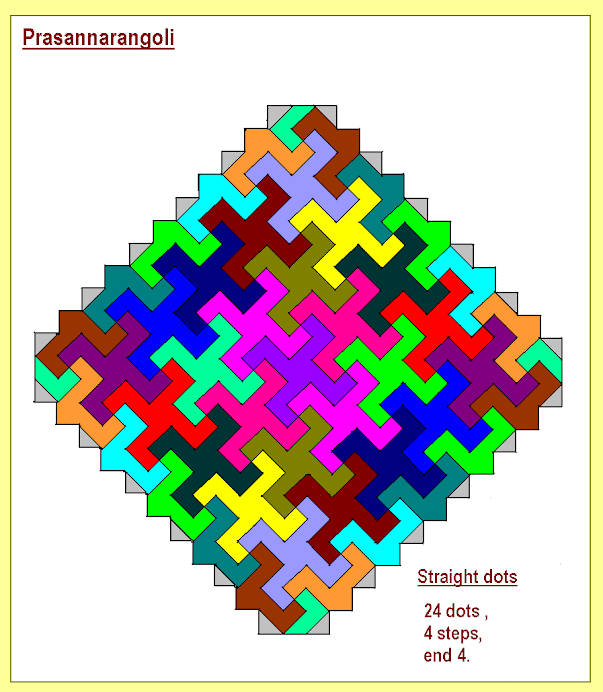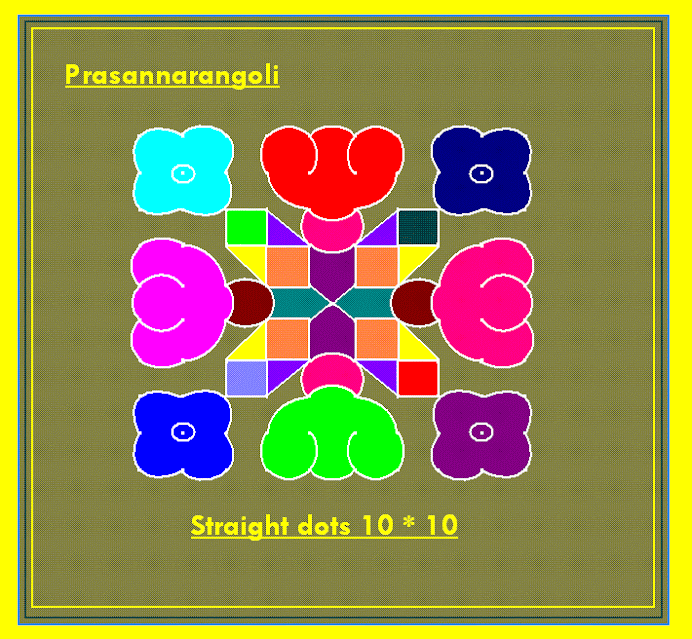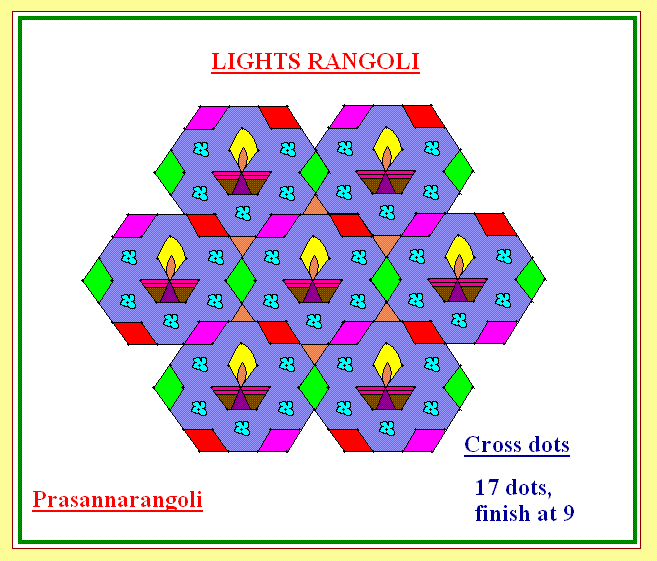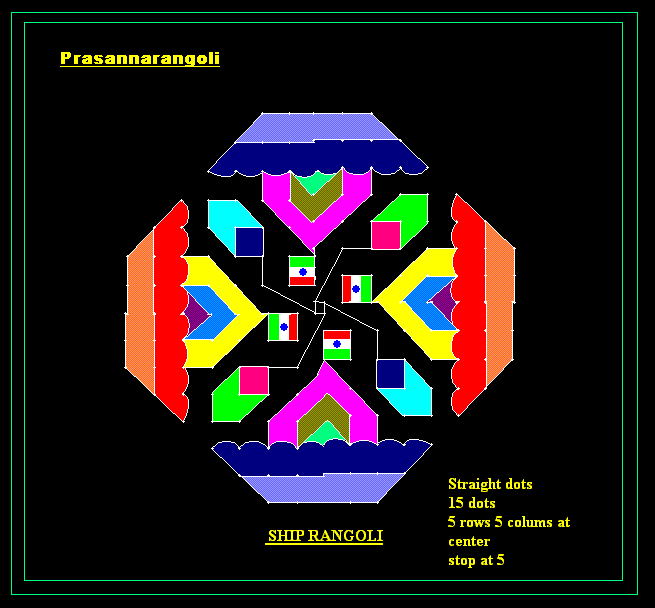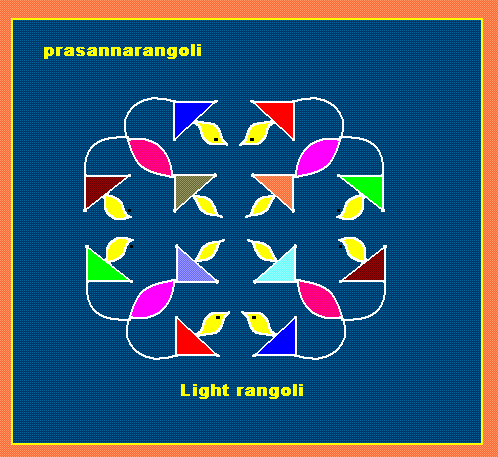Saturday, November 30, 2013
Sunday, November 10, 2013
Brief about kolam
Move through the streets of any village in Tamil Nadu, India, early in the morning, and try to find a home that does not have a beautiful pattern on the ground in front of the house, created from chalk or powder. You won’t be able to find one! You will be delighted by the sight of many decorative patterns covering the threshold of nearly every home. These traditional and decorative patterns are called kolam.Kolam is considered an auspicious form of Tamilian tradition. Kolam is a very attractive method of design formation around simple elements such as loops and dots. Kolams are drawn in front of the deities in pooja rooms and in front of houses. The proportional, geometric designs vary in different parts of India. Kolam is called hase in Karnataka, muggulu in Andhra Pradesh, alpana in Assam and Bengal, rangoli in Maharashtra and Gujarat, and chowkpurna in Uttar Pradesh.
The custom of drawing kolam was once believed to be very
ancient. However, research has suggested that the practice of drawing designs
on the floor dates back only six hundred years. References to kolam have been
found in Tamil literary works such as the 16th century Madurai
Meenakshiammai Kuram and in the 17th century Thiru Kutraala Kuravanji.
Both these literary works include information as to how to prepare a surface
before drawing in front of Lord Ganesh.
Villagers mix cow dung with water to sprinkle on the floor to make it smooth and even. Cow dung is also said to have antiseptic properties. After smoothing the floor with cow dung, the women arrange pulli (dots) around which the designs are drawn with lines. In literary works, it has been mentioned that people in ancient days used kumkum (red powder), sandalwood, and punugu (an excretion of the civit cat) to smooth the floor.
References to kolam have not been seen in any traveler’s account or in ancient paintings. However, some of the geometric designs used in creating kolam have found to be carved on the walls of ancient temple gopurams (towers).
In former days, the traditional colors were obtained from natural dyes. The natural colors have now largely been replaced with synthetic dyes, as they give bright hues.
In Tamil Nadu, women get up early in the morning and decorate their homes with kolam made up of rice powder. Rice powder was used in former days to provide nourishment to small animals such as ants and birds, thus welcoming the creatures to the home. The designs are expected to wear away during the day, and must be recreated each day.
Other materials are also used to create kolam, such as diluted rice paste, colored powder, marble powder, flowers, and leaves. On special occasions, limestone and red brick powder are used to add beauty to the kolam, with the designs made more elaborate and complicated.
In South India, kolam drawing is practiced by women of all ages. Girls learn this art from childhood – taught by their mothers and grandmothers. In rural areas, a bride is judged on her talent for creating kolam, as this skill is believed to demonstrate her discipline, grace, concentration, and dexterity.
Kolam is a type of art with mathematical properties, and traditional designs were strictly geometrical. Gradually, a representational style has emerged, which is used especially during celebrations. Designs are drawn according to the celebrated festival, and flowers and petals are used to decorate the kolam even more.
The Science of the Kolam
Let me begin with a doff of the hat to the Math and
Science Gene (MSG). He has marched tirelessly through countless
generations of my family, far, far back into the cobwebbed recesses of
ancestral lore and memory. He has worked hard, ceaselessly,
relentlessly, without ever skipping a single progeny of my clan. To be
sure, there were some dangerously close brushes with the Lunatic Gene
(LG) (known in polite circles as the Quirky Gene), but the MSG always
prevailed, always managed to nudge the LG, that over-ambitious and
irreverent upstart, aside. In a daring attempt at a coup, the Slothful
Gene once ventured to sabotage an entire sub-branch of my family, but
the MSG pulled them out of that potential morass, that almost-blight on
the family name, by sheer force of will.
“What’s the matter, old chap, you don’t look too good,” the LG said, his nasal voice grating on the MSG’s nerves just a little.
“I’m tired,” confessed the MSG. “I really need a break”.
The LG could not believe his ears.
“Yes, you do look a bit worse for the wear”, he
said, trying not to sound too eager. “Perhaps if you skip this one”
(nodding perfunctorily towards me, at the pinprick stage of
development), “you can come roaring back stronger than ever with the
next generation. Come on, it’s just one person! After all these centuries, surely they won’t mind if you took a break with one person!”
The MSG looked tempted. His defenses,
weak to begin with, began to crumble. It was true; a break would do him
good. He was beginning to get a bit worn at the edges, all those stray
genes from other communities (what a battle that had been!) were
beginning to take their toll. Whispers from the latest interloper, the
Management Gene, told him of the need to “regroup” and “reassess his
priorities”. He began to feel a bit resentful. He had been
taken for granted all these centuries, but if he vanished in one
person, it would shake them up and make them miss him and think
longingly of him. Yes! He would do it. He would take a break. And I would be the casualty of his decision.
The LG watched the MSG with ill-concealed eagerness. “So, you’ve decided, then?” he asked. “Can I move into your spot?”
A tremendous feeling of relief washed over the MSG, now that he had made his decision. He
felt relaxed and expansively generous. “Sure,” he exclaimed, waving his
hand at the LG, “You are most welcome.” A long-dormant and firmly
suppressed streak of mischief stirred awake in him. “And while you’re
moving in why don’t you invite your friend the Slothful Gene?”
So the LG moved into me, and employed his entire
arsenal of traits, the nature and composition of which I will leave to
your imagination. The Slothful Gene settled in very nicely as well,
having found an exceedingly hospitable environment in me.
And yes, the MSG, well-rested and rejuvenated, did
come roaring back in the next generation. My two children, I am told,
excel in Mathematics.
All this serves as a preamble and an apology for
the incoherent nature of what is to follow: an attempt to explain the
mathematics and the science of the kolam.
All over Tamil Nadu – urban or rural, at the homes
of the poor or rich, highly-educated or illiterate, an almost identical
ritual takes place early every morning. The threshold of
the home is swept, washed clean with a sprinkling of water, and, with a
handful of white powdered rice (or more commonly these days, stone), a
beautiful pattern is drawn out by hand. It is always done by a woman,
and is a wonderful way to showcase her artistry, skill and imagination.
The kolam may be a small, simple, hastily drawn lotus, or a plain and
straightforward six-pronged star, but on festival days, particularly
Pongal, the displays are mind-boggling in their colorfulness, complexity
and size.
I love my early morning walks when I am in Madras,
delight in watching the ritual of kolam drawing outside the homes around
where I live. It is heart-warming to see that in this age of hustle and
bustle, of high-tech gadgets and instant meals, people still take the
time and effort to create these works of art.
However (and this is where the lack of the MSG is
going to drag me down) kolams are so much more than pretty drawings.
They are a cultural and artistic expression of a whole array of
mathematical ideas and concepts (yes, mathematical). Kolams have
symmetry, patterned repetition, closed continuous curves and curve
families, all of which have applications and meaning in mathematics and
computer science. With their impeccably logical building up of patterns –
their algorithmic nature - they have attracted the attention of
computer scientists who have used kolams to study picture languages.
Kolams come in a variety of styles (which the
computer scientists have taken to calling “kolam families”). Many begin
with a grid of dots, which serve as the skeletal structure for the
kolam. Lines are drawn, connecting the dots or around
them, very often in a single, continuous curve. (An aside: the
continuous curve is supposedly symbolic of the never-ending cycle of
birth, fertility, death, continuity and eternity). The finished product
is a symmetrical kolam. Kolams come in a variety of symmetries –
horizontal, vertical and rotational.
A leader in the study of
the mathematical properties of kolams was Dr. Gift Siromoney of Madras
Christian College, who, along with his team, has done some fascinating
work on these lines. He was a pioneer in the study of kolam designs as
part of the analysis and understanding of picture languages. The
study of picture languages is closely related to formal language
theory, which has been used by computer scientists in the study and
development of programming languages. Picture languages use sets of basic units, and study the syntactic rules for combining these units. Using
the rules of syntax for a specific kolam family, a computer can
mechanically generate new kolam patterns. Gift Siromoney and his group
of scientists and mathematicians used these picture languages to
describe and create kolam families. They created a language that
produced strings of symbols, which could then be translated into
pictures (kolams).
Array languages are another technique used for the
mathematical and computational study of kolams, particularly those using
dots. These include Siromoney Matrix Grammars and Kolam Array Grammars. These arrays can be used to describe and create kolams of various shapes. I also recall reading
that Fibonacci numbers can be used to construct and design the dot
structures and patterns of kolams. Fibonacci numbers are a sequence
where the first two numbers are 0 and 1, and the subsequent numbers in
the sequence equal the sum of the previous two numbers.
The next time you go for an early morning stroll,
take a minute to watch the kolams being drawn, to see
mathematician-artists make science and art come alive before your eyes.
This is a tradition that goes back at least 300 years. May it live forever, and not just in the innards of a computer!
Subscribe to:
Comments (Atom)








